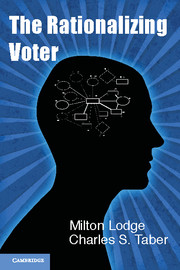Book contents
- Frontmatter
- Contents
- List of Tables
- List of Figures
- Preface
- 1 Unconscious Thinking on Political Judgment, Reasoning, and Behavior
- 2 The John Q. Public Model of Political Information Processing
- 3 Experimental Tests of Automatic Hot Cognition
- 4 Implicit Identifications in Political Information Processing
- 5 Affect Transfer and the Evaluation of Political Candidates
- 6 Affective Contagion and Political Thinking
- 7 Motivated Political Reasoning
- 8 A Computational Model of the Citizen as Motivated Reasoner
- 9 Affect, Cognition, Emotion
- Bibliography
- Index
Preface
Published online by Cambridge University Press: 05 March 2013
- Frontmatter
- Contents
- List of Tables
- List of Figures
- Preface
- 1 Unconscious Thinking on Political Judgment, Reasoning, and Behavior
- 2 The John Q. Public Model of Political Information Processing
- 3 Experimental Tests of Automatic Hot Cognition
- 4 Implicit Identifications in Political Information Processing
- 5 Affect Transfer and the Evaluation of Political Candidates
- 6 Affective Contagion and Political Thinking
- 7 Motivated Political Reasoning
- 8 A Computational Model of the Citizen as Motivated Reasoner
- 9 Affect, Cognition, Emotion
- Bibliography
- Index
Summary
This is a book about unconscious political thinking and the subterranean forces that determine how citizens evaluate political leaders, groups, and issues. It is the culmination of a twenty-year collaboration to chart the stream of information processing, which constructs political deliberation and behavior, and the impact of early, unnoticed feelings. This is a book about why the first 100 milliseconds of thought matters. It is about rationalizing, rather than rational, citizens.
This book was a long time in the making, in part because of teaching and administrative obligations, but more because of the explosion of research on unconscious thinking and on implicit attitudes and measures (see reviews in Gawronski and Payne, 2010; Petty, Fazio, and Brinol, 2009). In just the first quarter of 2011, five large volumes were published that apply implicit measures to a broad range of social phenomena: social conflict and aggression (Forgas et al., 2011); moral emotions (Giner-Sorolla, 2011); social identity and intergroup relations (Kramer et al., 2011); social judgment and decision making (Krueger, 2011); and, perhaps most importantly, the summing up and theoretical reconceptualization of a Nobel-winning research program on judgmental heuristics (Kahneman, 2011). While all of this is to the good, the sad fact is that it has become nearly impossible to keep up!
- Type
- Chapter
- Information
- The Rationalizing Voter , pp. xiii - xviPublisher: Cambridge University PressPrint publication year: 2013
- 1
- Cited by

